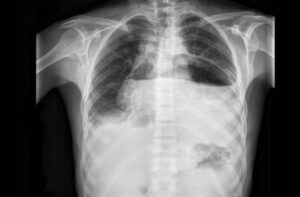This article is an answer to the Case – An Infant with Dark Brown Adherent Scales
This patient presents with steroid sulfatase deficiency, also known as X-linked recessive ichthyosis. Along with ichthyosis vulgaris, steroid sulfatase deficiency is one of the more common ichthyoses with an estimated incidence of 1 in 2000 to 9500 male births.
Pathogenesis
Seen almost exclusively in males, it is caused by a deletion or inactivating mutation of the entire STS gene on chromosome X, leading to the absence of or marked decrease in steroid sulfatase activity and subsequent inability to hydrolyze cholesterol sulfate and dehydroepiandrosterone sulfate (DHEAS).
Impaired hydrolysis leads to accumulation of cholesterol 3-sulfate in the epidermis, which inhibits transglutaminase-1, leading to abnormal cornification and clinical scaling of the skin.
Clinical Manifestations
In the neonatal period, steroid sulfatase deficiency may present with mild erythroderma followed by peeling of large translucent scales.
As infants grow older, they develop darker brown or characteristically ‘dirty’ appearing polygonal scales that almost always involve the neck and often involve the trunk and extremities. Flexural areas are often spared. Unlike ichthyosis vulgaris, this condition does not typically improve with age.
Prolonged labor or failure to initiate labor can be seen in women with an affected fetus. Steroid sulfatase deficiency in the placenta can cause low or absent levels of estrogen in the urine and amniotic fluid, which causes insufficient dilation of the cervix, often requiring cesarean section for delivery.
Complications
Patients with steroid sulfatase deficiency have a 20-fold increased incidence of cryptorchidism and have a higher risk for developing testicular cancer and hypogonadism.
Asymptomatic corneal opacities can be seen in up to 50% of patients, and other rare associated non-cutaneous findings include seizures, developmental delay and acute lymphoblastic leukemia.
Treatment
Treatment involves the application of topical humectants, keratolytics and retinoids. Systemic treatment is rarely indicated.

